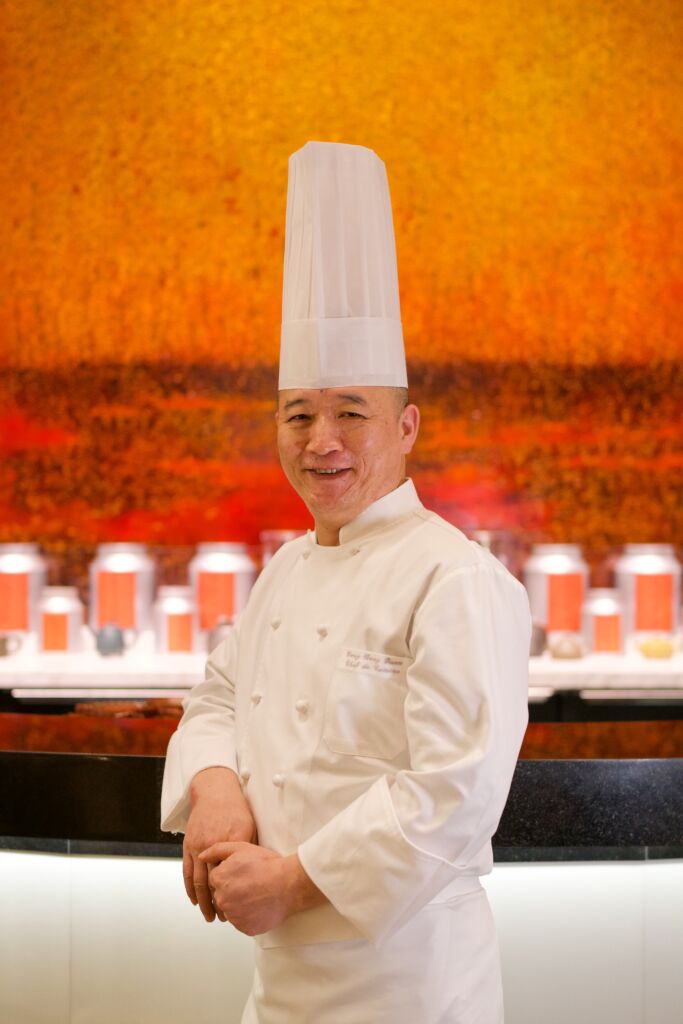One of the most influential in China, Sichuan cuisine is as complex as it is often misunderstood. As it spreads beyond the borders of its birthplace, it became famed for fiery flavors and tingly numbness sensations. Be that as it may, there’s more to Sichuan food than blazing, mouth-numbing escapades. Essentially, its foundation relies on 24 different flavors that stem from an alchemy of five basic tastes: sweet, sour, savory, bitter and spicy. Born and raised in Chengdu, Chef Yang Dengquan helms the kitchen at MGM Cotai’s Five Foot Road to showcase the depth of Sichuan cuisine through pure and refined creations that honor its rich gastronomic heritage. After a superb tasting experience that was all but spicy, Chef Yang Dengquan sat with us to talk about this complex gastronomy and some of the common misconceptions around it.
How did you become a chef and what inspired you to pursue a career in culinary?
I love food and I love to eat (laughs)! I also wanted a job that required fine skill and technique, something that I could do with my own hands. That’s the reason I pursued culinary arts–I find it to be an art form.
You were born and raised in Chengdu. Is there any dish that takes you back to your roots?
Too many! It’s hard to name one. From the five basic tastes, we can create hundreds of flavors. But chili pepper fish and kung pao chicken are some of the dishes that come to mind. Both are very authentic and traditional Sichuan dishes.
You were responsible for the cuisine concept and menu design at Five Foot Road. Have you incorporated any of these dishes into the menu?
Yes, both are available from Five Foot Road’s menu. When designing the menu I had to take into consideration different factors, like what ingredients are available and what are the ingredient restrictions we face. I make a point of using seasonal ingredients, many directly sourced from Sichuan. Two further factors to consider are its acceptance by our local guests and the climate here in Macau. Since Five Foot Road opened in 2018, we’ve adjusted about 60% of the menu to ensure it matches the locals’ taste, without compromising on the authenticity, of course. The number of local guests has been constantly increasing, we have a loyal customer base. Our menu features nearly all of the dishes most Sichuan restaurants would offer, plus dishes that aren’t so commonly found because they are extremely time-consuming and requires certain knowledge. But the most precious aspect to make it all happen, is my team, whereas 90% of them are from Sichuan, with years of experience in the kitchen.
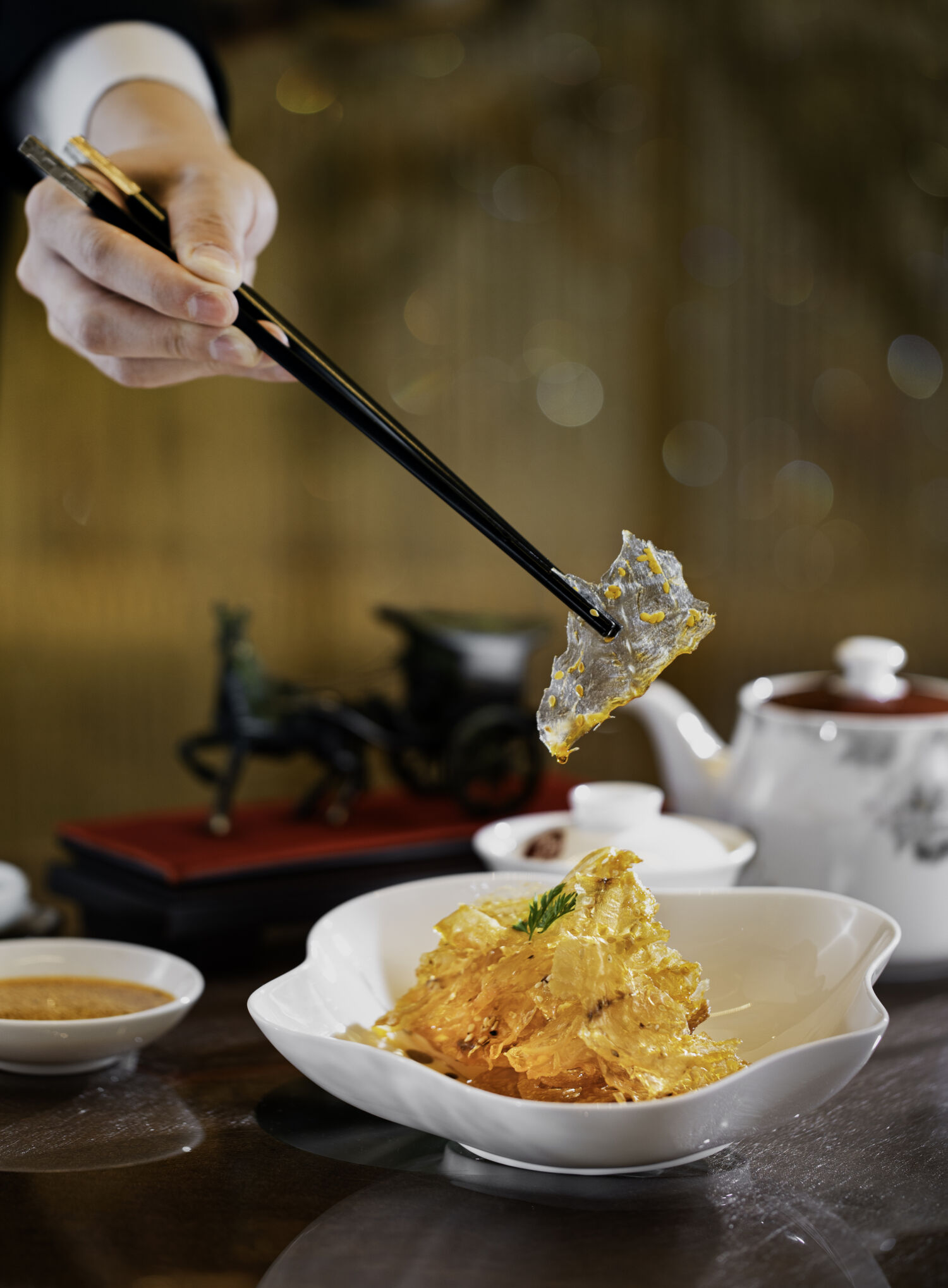
Crispy Mullet Carpaccio with Sichuan Peppercorn Sauce; Photo credit: MGM Cotai
Chengdu is Asia’s first UNESCO City of Gastronomy and has a rich and unique culinary culture, perhaps the most famed in China. What characterizes Sichuan cuisine?
Sichuan cuisine is characterized by both spicy and non-spicy flavors and makes use of unique ingredients that are rare to find in other cuisines in China, like Sichuan pepper and Sichuan-style pickled chili. We use Er Jing Tiao chili (二荆条) to make pickled chili. We have a very particular way of preparing pickled vegetables in Sichuan, different from those of Korea and other countries. But I’ll keep the technique a secret (laughs)! Take for example a very popular Sichuan dish, braised eggplant with minced pork. Even though we don’t use any fish sauce on this dish, it still builds up a super fresh and seafood-y flavor thanks to the Sichuan-style pickled chili. It’s such a magical ingredient!
Sichuan cuisine isn’t always fully understood and there are a few misconceptions around it, would you agree?
I agree. A long time ago, numerous Sichuan chefs left the province to work abroad or in Chinese cities outside Sichuan. These chefs had to showcase the many, diversified Chinese flavors among a number of dishes within a single menu. They were unable to focus solely on Sichuan food, even if the restaurant they worked at was positioned as a Sichuan food place. Instead, they selected the most iconic dishes from each region, invariably recreating the spicy dishes Sichuan is famed for to represent the province. My team at Five Foot Road has a mission to help change people’s perception of what Sichuan food truly is, and they are given the freedom to offer what isn’t often found in other restaurants focused on Sichuan cuisine.
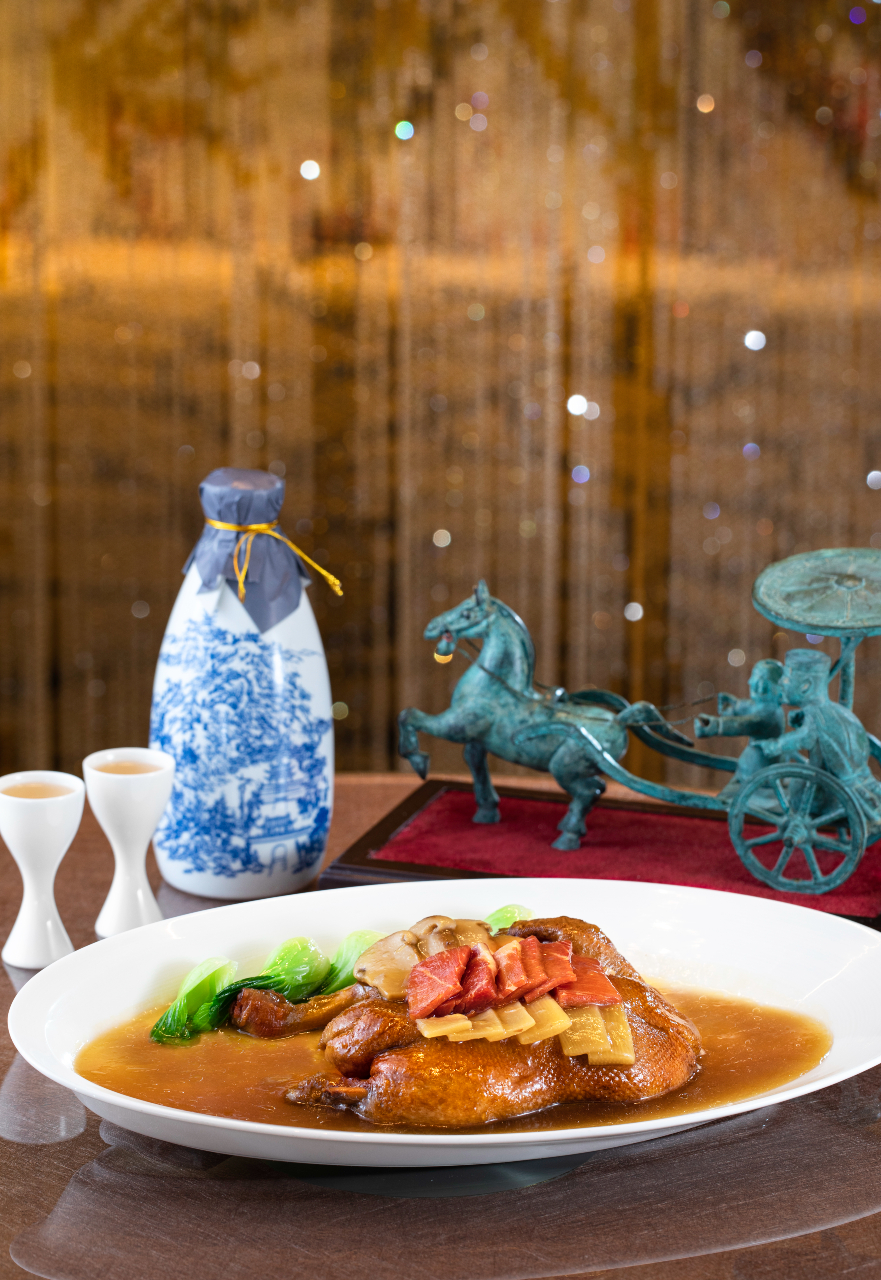
Flavor profile: Salty and fresh flavor, followed by sweetness and aroma of hua diao wine
People often associate Sichuan food with spiciness, but it’s more than that. What are some of the authentic ingredients, flavors, and aromas that you identify with Sichuan cuisine?
In Sichuan cuisine, each dish has its own character, a hundred dishes will have a hundred different flavors. I use a lot of hua diao wine (花雕酒), which adds a very distinct fragrance and taste, fresh lotus leaf, and Sichuan style pickled bean sprout. But Sichuan cuisine is incredibly diverse and somewhat complex, it is guided by a framework of 24 flavors. This kaleidoscope of flavors stems from different combinations of the five basic flavors: sour, sweet, numbing, spicy, and savory. The intensity of each flavor, cooking technique, control of fire, and the interaction of different ingredients spark chemical reactions that result in a matrix of flavor profiles. While designing the menu, I had to make sure that all of these 24 iconic flavors within the cuisine were somehow incorporated to ensure guests had an authentic showcase of this gastronomy.
My culinary team and I work closely with the restaurant management team. This is crucial because they are the ones who deal with our guests face to face on a regular basis. The restaurant management team, headed by Vicky, has a very deep knowledge of our menu and knows the stories behind every dish. They guide guests through the dining experience by introducing them to different types of flavors, and by sharing their knowledge of the menu and, in a broad sense, Sichuan cuisine.
How would you differentiate spiciness and mala? Which is more likely to cause a mouth-numbing sensation?
“Mala”, in Chinese, are the two characters that are combined to describe the numbing sensation (ma 麻) and spiciness (la 辣). Numbness is caused by a tingling sensation as if something was dancing in our mouth, a distinctive characteristic of the Sichuan peppercorns. When we have mala, the numbing sensation hits first, followed by the spicy taste, which we feel as if it came from the inside like something burns down to our stomach. Dan dan noodles are a good example of a mala dish. However, mala is one of the misconceptions of Sichuan cuisine; while it is an emblem of the cuisine, it’s important to point out that it does not represent its wholeness. Spiciness is a flavor that blends beautifully with any flavor within the 24 that compose the foundation of Sichuan cuisine. It is a single trigger to our tongue and stomach and causes a fiery sensation.
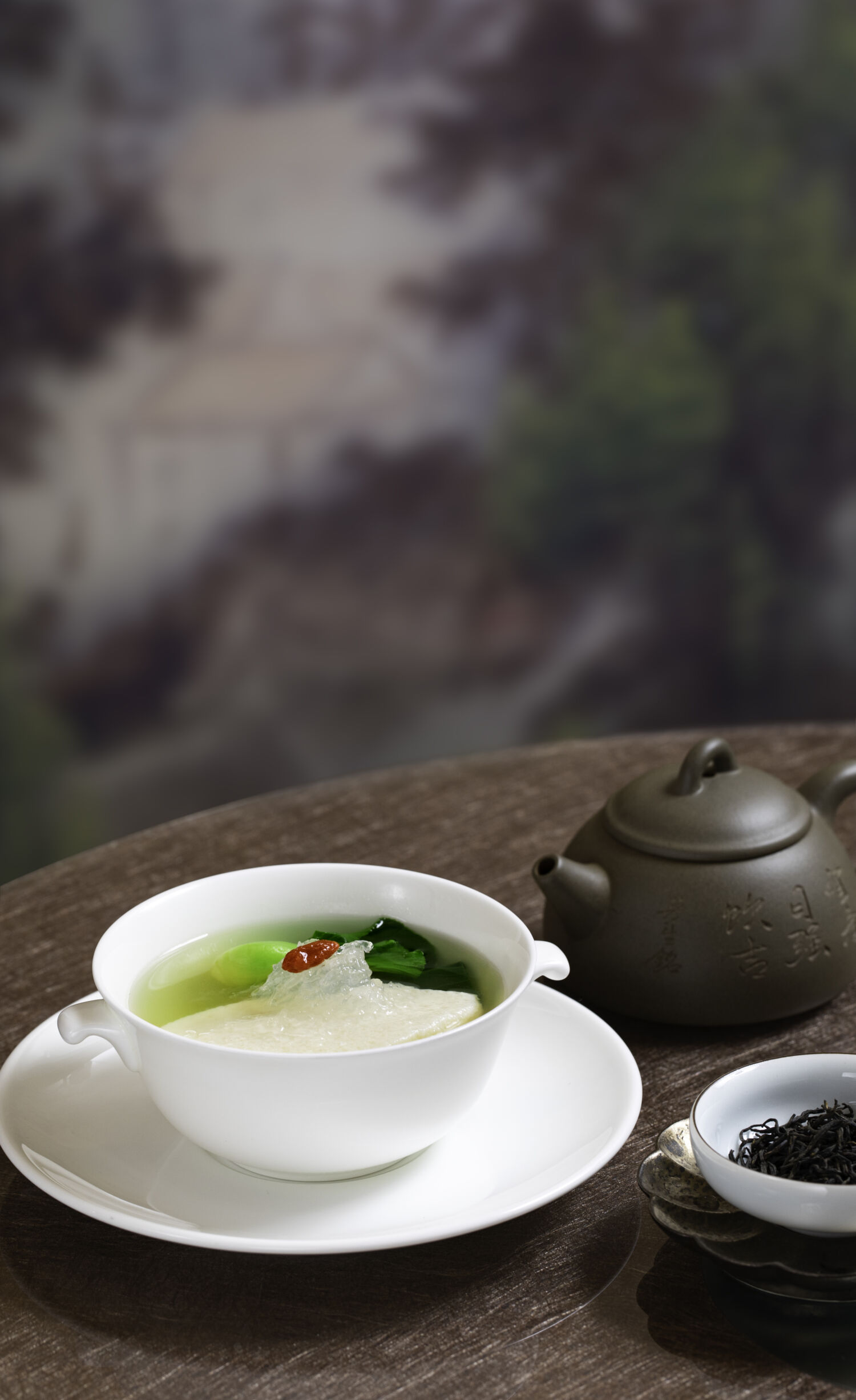
Stewed Minced Chicken Bouillon with Bird’s Nest; Photo credit: MGM Cotai
For someone looking to try Sichuan cuisine for the first time who might worry about it being too spicy, what dishes would you recommend them to start out with and why?
In the 24 flavor profiles, there are a few that are non-spicy, and rather, the flavors of the ingredient is accentuated by mild spices and cooking technique. With that in mind, I’d recommend two meat dishes: steamed beef short ribs with homemade sauce in lotus leaves and pan-fried tofu with minced chicken paste These two are not spicy, although served with chili sauce and chili powder on the side, respectively, for guests who opt for something with a kick. Then I’d also recommend two soups that are more refined dishes and often served in official national banquets held for state dignitaries: poached Chinese cabbage in bouillon, and stewed bird’s nest with minced chicken and egg white in bouillon. The bouillon is the essence of both of these soups. It looks like an ordinary, clear broth, but is actually a burst of flavors from the chicken and other ingredients, but yet, it does not overpower the sweetness from the cabbage, not the minced chicken and egg white. To achieve this takes patience and skills accumulated over years of practice and understanding the cuisine.
At Five Foot Road, you use traditional methods to craft true Chengdu flavors and present them in fine, dainty creations. How do you strike a balance between keeping authenticity while elevating a dish to fit into the fine dining category?
Although I follow traditional culinary art to create my dishes, I spend a lot of time and effort on plating to make refined, modernized presentations. In addition to this mixture of traditional and modern, I source the best ingredients to create a dish and work with what is in season. For example, almost all of the seasonings we use come straight from Sichuan, even salt, and we source mushrooms from Yunnan because those are the best ones. The same goes for all other ingredients we use in our kitchen; they’re sourced from wherever their grade is superior.
Five Foot Road offers guests a one-of-a-kind dining experience that draws from banquets that the wealthy Chengdu high-society used to host at their mansions during the Chinese Republican era in the 1940s. Can you tell us more about this concept?
Those banquets were social events that took place in the 40s among the upper class, with each family seeking to reaffirm their social status through them. Everyone wanted to be known for hosting the fanciest and most abundant banquet, overflowing with fine foods, and for having the best chefs preparing the feast. There was a strong culture of one-upness. Those families used to hire their own chefs to curate evenings and evenings of delicious, meticulous food from the household kitchen, and that is where we draw our inspirations from. Refined Sichuan comfort food that pays homage to the culture and traditions.
If we were to time travel to one of these exclusive banquets, what dishes would we find? What were the food trends of 80 years ago?
That would depend on the season, it was all about seasonal ingredients back then. Agricultural methods were not yet developed so people could only work with seasonal produce, nothing else. There is a traditional dish that was quite popular and often served during the 40s that we included in the menu at Five Foot Road: crispy fried yellow croaker with dried pork, preserved vegetable, and pickled chili. The fish’s stomach is filled with bean sprout and pickled chili before it’s coated in pork fat and deep-fried. With the time and effort that is required to properly present this dish, it’s not easy to find it in most Sichuan restaurants nowadays.
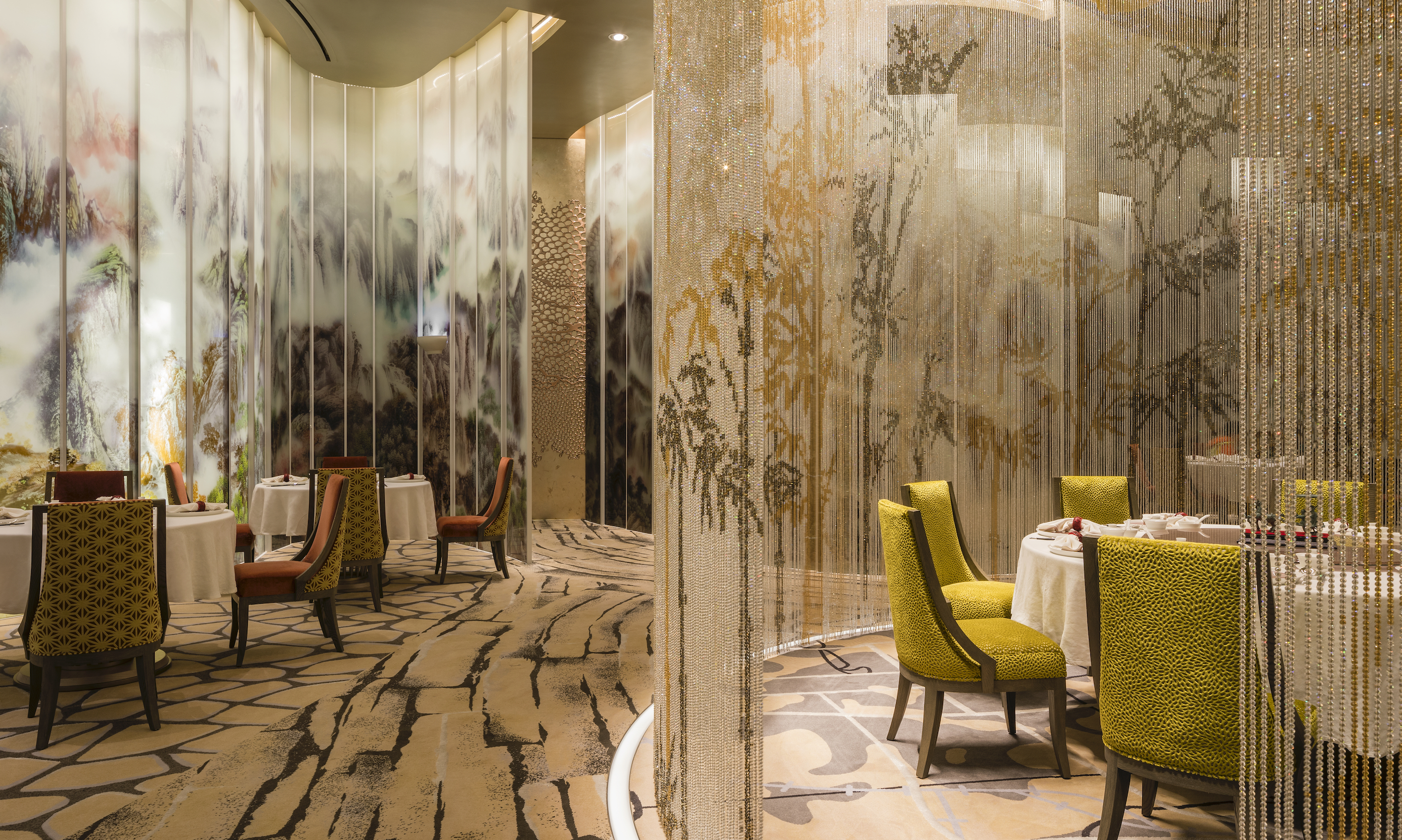
Photo credit: MGM Cotai
Five Foot Road’s interiors are filled with Chinese ornaments, landscape paintings, and poetry references that take inspiration from classic Chengdu mansions. Do you think the combination of thoughtful interiors and true Chengdu cuisine allow guests to experience Sichuan culture through dining here?
No doubt. The restaurant’s interiors show the beautiful sceneries of Sichuan throughout the seasons, guests feel like they’re surrounded by mountains which are actually ink paintings on wall-to-ceiling glass panels. The design is evocative of an important part of history, The Silk Road, when traders would travel along the route with five-foot-wide carts, which the restaurant was named after. That, combined with a modern interpretation of the exquisite dishes savored by the big families in the 40s, provides an experience in which both concepts smoothly merge.
What are the signature dishes at Five Foot Road?
Besides the two soups mentioned before, Dan Dan Noodles with Minced Pork and Soya Bean Sauce, Crispy Mullet Carpaccio with Sichuan Peppercorn Sauce, Stewed Duck with Matsutake Mushroom, Ginger, Ham, and Seasonal Vegetables, and Marinated Fresh Abalone Sichuan Style are signature dishes. My personal favorites are Marinated Fresh Abalone–marinated over four hours in over 30 indigenous Sichuan herbs–and the Bird’s Nest Soup!
You have over 30 years of experience under your belt. What are some of the most important lessons you’ve learned over the years?
I believe learning should be an ongoing process, we must remain open to it. My personal philosophy is to keep on learning.
Go on a journey through authentic Sichuan flavors crafted by Chef Yang Dengquan at Five Foot Road in MGM Cotai
Five Foot Road MGM Cotai, Avenida da Nave Desportiva, Cotai, +853 8806 2358, www.mgm.mo

